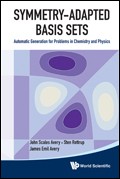 |
In theoretical physics, theoretical chemistry and engineering, one often wishes to solve partial differential equations subject to a set of boundary conditions. This gives rise to eigenvalue problems of which some solutions may be very difficult to find. For example, the problem of finding eigenfunctions and eigenvalues for the Hamiltonian of a many-particle system is usually so difficult that it requires approximate methods, the most common of which is expansion of the eigenfunctions in terms of basis functions that obey the boundary conditions of the problem. The computational effort needed in such problems can be much reduced by making use of symmetry-adapted basis functions. The conventional method for generating symmetry-adapted basis sets is through the application of group theory, but this can be difficult. This book describes an easier method for generating symmetry-adapted basis sets automatically with computer techniques. The method has a wide range of applicability, and can be used to solve difficult eigenvalue problems in a number of fields. The book is of special interest to quantum theorists, computer scientists, computational chemists and applied mathematicians.
|